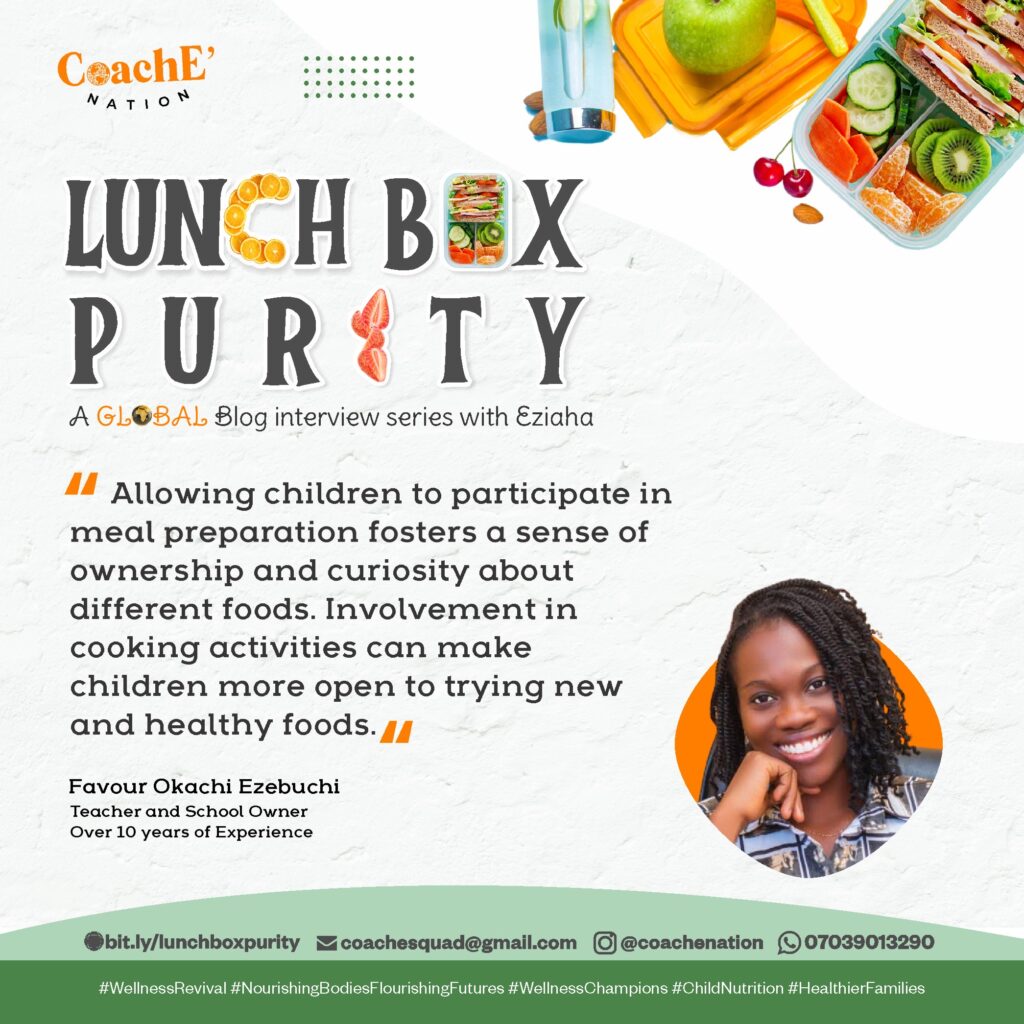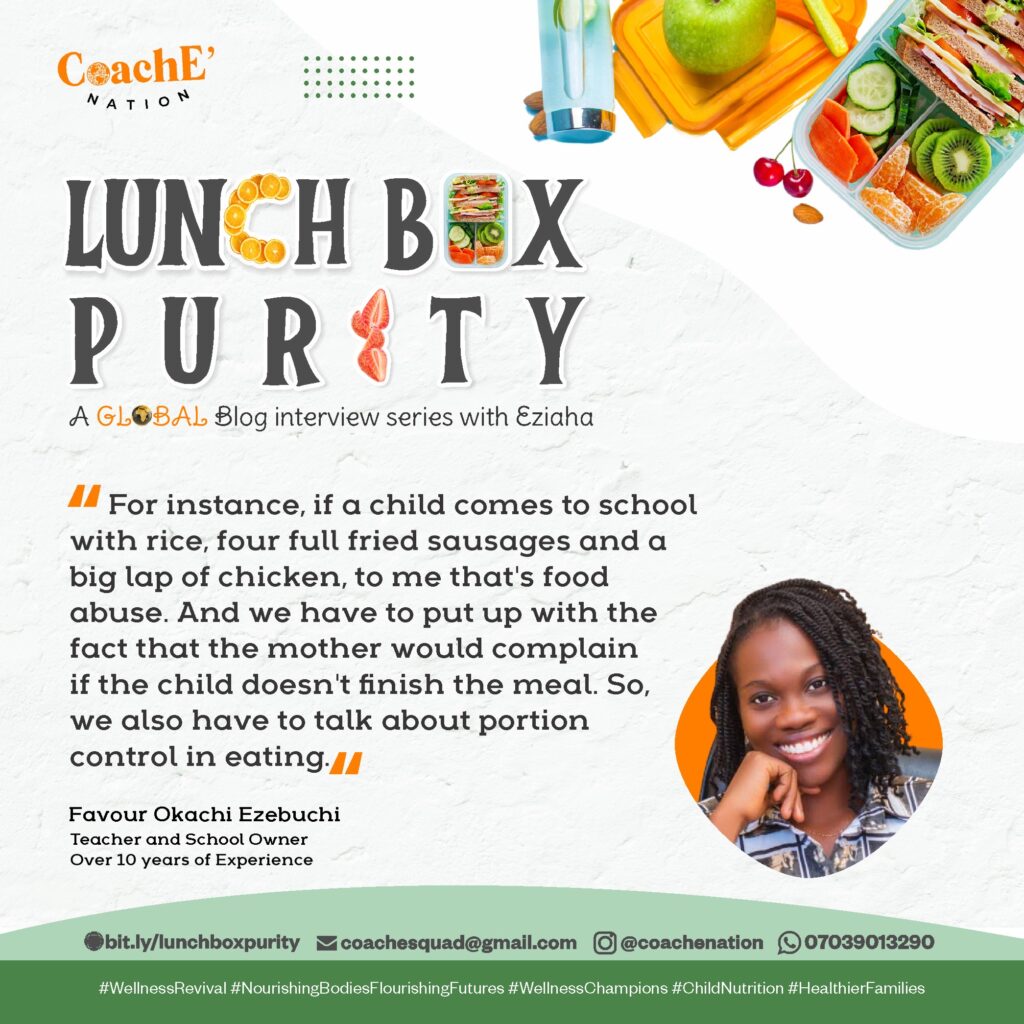
For instance, if a child comes to school with rice, 4 full fried sausage and a big lap of chicken, to me it’s food abuse. And we have to put up with the fact that the mother would complain if the child doesn’t finish the meal. So we have to talk about portion control in eating. – Favour Okachi Ezebuchi

Question 1
Please tell us your name, where you currently teach, years on the job and how you got into the beautiful world of education?
Answer
My name is Favour Okachi Ezebuchi, i currently teach at Bastion School. I have been teaching since 2014 – till date (10years)
After completing my secondary education, I purchased the JAMB form and selected Niger Delta University and University of Lagos as my preferred choices. On the day I was set to submit the form, my elder brother inquired about my chosen universities. Upon seeing my selection, he used a razor to remove Niger Delta University and replaced it with the University of Science and Technology, now known as Rivers State University. I was displeased as I had hoped to venture far from my hometown of Port Harcourt, where I had spent my entire life.
Despite my initial reluctance, I went ahead with the JAMB exam and passed. Subsequently, I participated in the university’s aptitude test and was admitted into the Business Education program with a Management option. Although I was initially disheartened, I called my father, who advised me to come home. On my way home, I encountered my distant cousin, who inquired about my troubles. After expressing my reluctance to become a teacher, he provided encouragement, assuring me that I could still graduate with a BSc and work in an office rather than as a teacher.
In my final year at the university, I received what I believe was divine guidance urging me to visit Winners Chapel, a church I had never attended or knew much about. During a month focused on “Knowing God’s Plan for Your Life” in September 2011, I sought God’s guidance, and during a sermon, the pastor spoke about teaching, which resonated with me as an answer to my concerns.
After completing my service year, I started searching for office jobs. A week before my wedding in June 2014, I secured a secretary position, only to find myself handling cleaning duties and being the sole employee with no computer or tasks. Frustrated with my lack of experience and meaningful work, I prayed for a change. That evening, I received a call from Port Harcourt International Campus, where I had interviewed in February 2014, offering me a teaching position. This marked the beginning of my journey into the field of education.

Question 2
Your most significant/memorable experience as an Educator
Answer
One of my most significant and cherished experiences as an educator occurred on January 1st, 2018, when I had a clear vision about initiating Bastion School. What stands out even more profoundly is the guidance I received from the Holy Spirit, leading me to unlock the secrets of teaching children to read and write. This unique aspect of my journey is something I hold in high regard and treasure deeply.

Question 3
How can the Government, Federal or State throw their weight behind schools in terms of policies for example) in the fight to ensure that at least with schools, child nutrition is front and centre?
Answer
The government can throw their weight to ensure that Child nutrition is in front through the following:
- National School Nutrition Policies: Develop and implement comprehensive national school nutrition policies that set clear standards for the nutritional content of school meals and snacks. Ensure these policies are evidence-based and aligned with dietary guidelines to promote healthy eating habits.
- Nutrition Education Programs: Integrate nutrition education into the school curriculum to enhance students’ understanding of the importance of healthy eating. Provide training and resources for teachers to incorporate nutrition education into their lessons.
- Healthy School Meal Programs: Establish and enforce guidelines for the nutritional quality of school meals, emphasizing a balance of fruits, vegetables, whole grains, and lean proteins. Support initiatives that provide free or subsidized nutritious meals for students, especially those from low-income families.
- Collaboration with Health Departments: Foster collaboration between the education and health departments to ensure a holistic approach to child well-being, linking school nutrition programs with broader health initiatives.
- Infrastructure and Facilities: Invest in infrastructure and facilities that support the preparation and serving of nutritious meals in schools, including well-equipped kitchens and dining areas

Question 4
What role can parents play in supporting your efforts to promote healthy eating? How best should we communicate with parents about the importance of nutritious lunches? Do you have any practical success stories on this?
Answer
Thiese are the roles parents can play to promote healthy eating:
- Role Modeling: Children often model their behavior after the adults around them, particularly their parents or caregivers. If parents demonstrate healthy eating habits and a positive attitude toward nutritious foods, children are more likely to adopt similar behaviors.
- Involving Children in Meal Preparation: Allowing children to participate in meal preparation fosters a sense of ownership and curiosity about different foods. Involvement in cooking activities can make children more open to trying new and healthy foods.
- Consistent Messages: Consistency in messages about the importance of balanced nutrition reinforces healthy eating habits. Parents who consistently communicate the value of a balanced diet contribute to a child’s understanding of the importance of nutritious food choices.
- Availability of Healthy Options: Parents and caregivers control the types of foods available at home. If a home environment prioritizes fruits, vegetables, whole grains, and other nutritious options, children are more likely to choose these foods.
- Limiting Access to Unhealthy Foods: Controlling access to sugary snacks, processed foods, and sugary beverages at home can positively influence a child’s food choices. Parents who set limits on less nutritious options encourage healthier selections.
- Share Educational Resources: Distribute educational materials, such as pamphlets, brochures, or newsletters, that offer practical tips on preparing nutritious lunches. Include information on portion sizes, food groups, and the nutritional content of different foods.
- Organize Workshops and Webinars: Conduct workshops or webinars for parents to provide in-depth information on nutrition and the importance of balanced meals. Allow for Q&A sessions to address specific questions and concerns practical and logistical obstacles.
Schools must take into account factors such as parental preferences where Parents have different beliefs about what constitutes healthy food, and there may be varying cultural diversity or dietary considerations. A complete ban on certain items may face resistance from some parents, and the feasibility of enforcing such a stringent policy. Instead of an outright ban, schools can focus on educating students, parents, and staff about healthy eating habits. Collaborating with parents to encourage healthier choices and providing information on nutrition can be more effective in the long run.

Question 5
Have you ever been a part of a transitioning process in the school? By this, I mean where the school decides that we would have junk-free days a few times a week, or even junk-free days everyday. If yes, how was that transition process and what was the outcome like? What impact did you see in the children? And if you were to help another school transition, what are the best practices you would recommend to make it seamless?
Answer
Yes, I have. The transition process wasn’t difficult as such. On Thursdays they could come in with Juice and every other day would be cooked food and Snacks. Some of them still came with some junks as snacks but we kept on sending it back. The acceptable snacks is fruits.
What I noticed is that the school is usually calm whenever it’s not a Juice day. This is because sugar has a way of increasing children’s energy. If I am to help a school transition, the best practice will be to call for a parent meeting and organize a talk show on this. We must make them understand what junk really is, it impact on children and even they as adults. The truth is most people don’t know what junk really is so they feel that if they were deprived of all these due to financial situation while growing up then their child shouldn’t be denied of it.
For instance, if a child comes to school with rice, 4 full fried sausage and a big lap of chicken, to me it’s food abuse. And we have to put up with the fact that the mother would complain if the child doesn’t finish the meal. So we have to talk about portion control in eating. Another best practice would be a parent workshop and nutrition program. But most importantly, we must make sure the parents and teachers are involved in the transition process. This would be the easiest way.

Question 6
Are there times when an Educator (you or someone else) has had to intervene per the content of a child’s lunch box, especially when you can see that the frequency and volume can negatively impact on the child’s health both short term and especially long term? If yes, how did that go and/or how can an Educator help/intervene without coming across as being judgmental? How do we educate that child and/or the parent into better and healthier decisions?
Answer
Yes please. There’s this lady with an overweight child which resulted in the fact that he took adult dosage when taking medications otherwise it won’t work. This is one of the things obesity can cause.Back to my story, this child always comes to school with Beans and egg. Yes, I know it’s protein but we hardly see other food or even fruits. And then his snacks would always be pastries with two or three juices.And this is a child who cannot sit Chriscross nor stand up back without assistance. This position is supposed to make children more comfortable and relaxed when they are doing a group tasks.
Infact, when he’s going up a staircase, he takes it one step at a time while using the stairs handle as a support for himself and he’s around seven or eight years old.We spoke to his mum, and then fruits and vegetables were now coming to his meal, but it didn’t last because she wasn’t used to it. She also began to think we were trying to punish the child. So, it’s important that the awareness is created. Parents must understand what this is all about and what junk is doing to their child.When a school has a high standard in terms of education hasn’t been compromised over time you can influence the parents of your students.
If it’s coming from an educator then the educator must first make sure his/her school is delivering value in all ramifications otherwise the parents may not give you a listening ear.We have to actively promote healthier food options. We also have to highlight the benefit of this choices and provide nutritional information that’ll empower the children to be informed. So that when the parents is eliminating certain foods, the child knows ‘why’ and doesn’t meet the decision with opposition.
Also, we should incorporate practical cooking lessons on healthy meals. Teach them and then cook it with them. You can’t just teach theoretically without implementing practically for the child to see. If you want to include the parents that’s ok too. Teach basic cooking skill , share simple healthy recipes and educate them on how these can be so nutritious to their health.We can also model by planting school gardens, where we grow vegetables and you make students have access to them.

School, parents and educators must also lead by examples. You can’t teach healthy meals to students and they watch you eat junks during break. When children see adults making nutritious choices automatically they follow suite.And we have to keep reminding both the students and parents to eat healthy. If we want to see impact , you have to keep reminding them.
I am sure you learnt a lot from this short but really informing interview. Next week Monday, we are featuring our last but not the lead Superstar Educator. They actually don’t get to answer the same set of Q’s so get excited about reading a wide array of Q and A’s!
And please support and spread the WORD that the LUNCH BOX PURITY blog series is LIVE!
You can create your own customized flier here and then share the link to the amazing Parents and Educators in your circle.
Ok, see you next Monday with our Super star Educator talking LUNCH BOX PURITY!
With all my HEALTHY Love!
Eziaha,
Wellness Revivalist and Lunch Box Purity
PS
Follow me on my brand new IG here after being away for over four years, and on LinkedIn here. My YouTube channels is value-choked and you can join that family here
